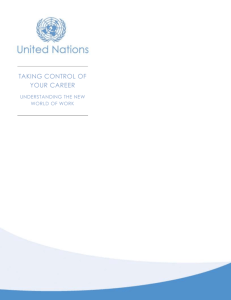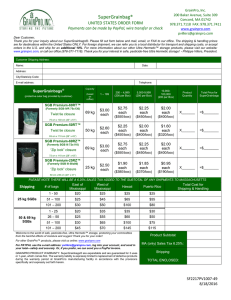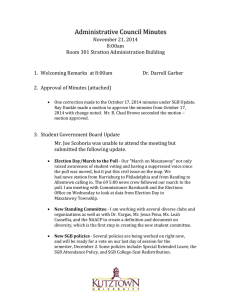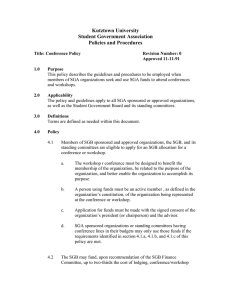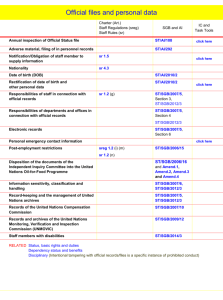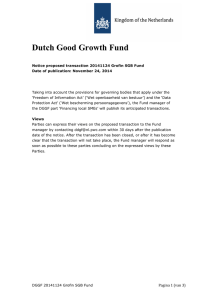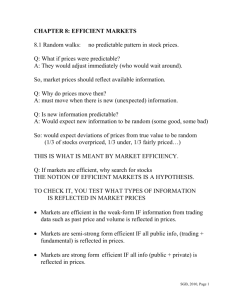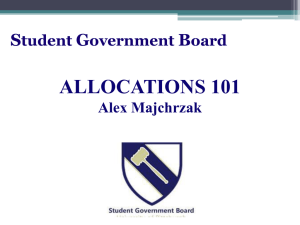Impacts of stellate ganglion block on plasma NF
advertisement
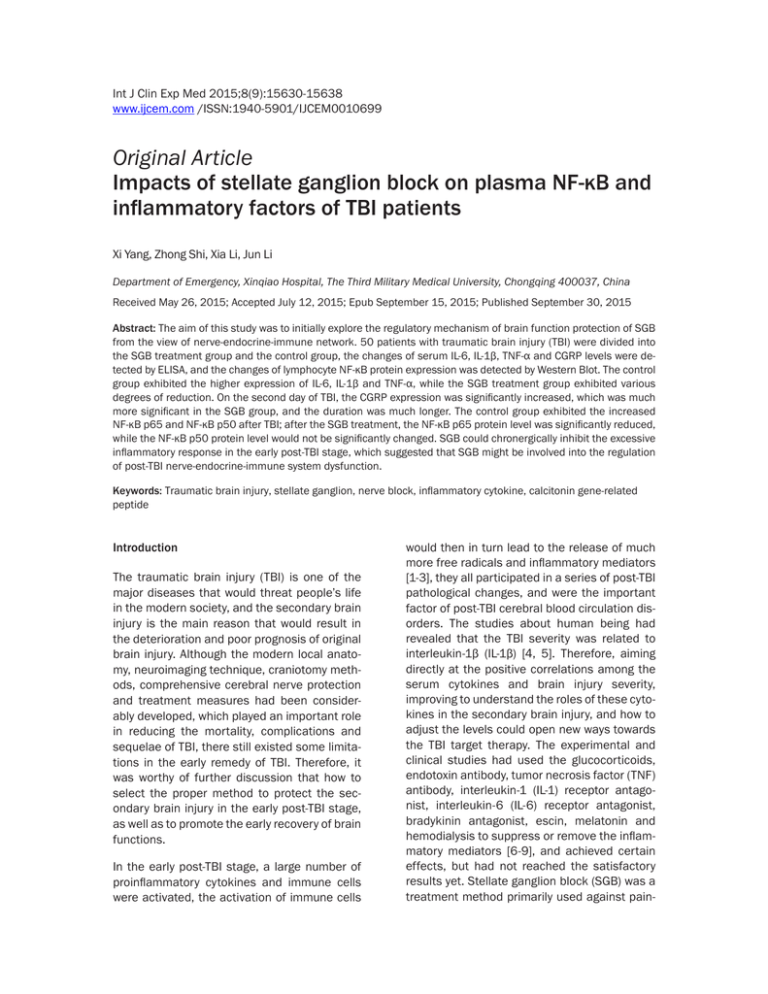
Int J Clin Exp Med 2015;8(9):15630-15638 www.ijcem.com /ISSN:1940-5901/IJCEM0010699 Original Article Impacts of stellate ganglion block on plasma NF-κB and inflammatory factors of TBI patients Xi Yang, Zhong Shi, Xia Li, Jun Li Department of Emergency, Xinqiao Hospital, The Third Military Medical University, Chongqing 400037, China Received May 26, 2015; Accepted July 12, 2015; Epub September 15, 2015; Published September 30, 2015 Abstract: The aim of this study was to initially explore the regulatory mechanism of brain function protection of SGB from the view of nerve-endocrine-immune network. 50 patients with traumatic brain injury (TBI) were divided into the SGB treatment group and the control group, the changes of serum IL-6, IL-1β, TNF-α and CGRP levels were detected by ELISA, and the changes of lymphocyte NF-κB protein expression was detected by Western Blot. The control group exhibited the higher expression of IL-6, IL-1β and TNF-α, while the SGB treatment group exhibited various degrees of reduction. On the second day of TBI, the CGRP expression was significantly increased, which was much more significant in the SGB group, and the duration was much longer. The control group exhibited the increased NF-κB p65 and NF-κB p50 after TBI; after the SGB treatment, the NF-κB p65 protein level was significantly reduced, while the NF-κB p50 protein level would not be significantly changed. SGB could chronergically inhibit the excessive inflammatory response in the early post-TBI stage, which suggested that SGB might be involved into the regulation of post-TBI nerve-endocrine-immune system dysfunction. Keywords: Traumatic brain injury, stellate ganglion, nerve block, inflammatory cytokine, calcitonin gene-related peptide Introduction The traumatic brain injury (TBI) is one of the major diseases that would threat people’s life in the modern society, and the secondary brain injury is the main reason that would result in the deterioration and poor prognosis of original brain injury. Although the modern local anatomy, neuroimaging technique, craniotomy methods, comprehensive cerebral nerve protection and treatment measures had been considerably developed, which played an important role in reducing the mortality, complications and sequelae of TBI, there still existed some limitations in the early remedy of TBI. Therefore, it was worthy of further discussion that how to select the proper method to protect the secondary brain injury in the early post-TBI stage, as well as to promote the early recovery of brain functions. In the early post-TBI stage, a large number of proinflammatory cytokines and immune cells were activated, the activation of immune cells would then in turn lead to the release of much more free radicals and inflammatory mediators [1-3], they all participated in a series of post-TBI pathological changes, and were the important factor of post-TBI cerebral blood circulation disorders. The studies about human being had revealed that the TBI severity was related to interleukin-1β (IL-1β) [4, 5]. Therefore, aiming directly at the positive correlations among the serum cytokines and brain injury severity, improving to understand the roles of these cytokines in the secondary brain injury, and how to adjust the levels could open new ways towards the TBI target therapy. The experimental and clinical studies had used the glucocorticoids, endotoxin antibody, tumor necrosis factor (TNF) antibody, interleukin-1 (IL-1) receptor antagonist, interleukin-6 (IL-6) receptor antagonist, bradykinin antagonist, escin, melatonin and hemodialysis to suppress or remove the inflammatory mediators [6-9], and achieved certain effects, but had not reached the satisfactory results yet. Stellate ganglion block (SGB) was a treatment method primarily used against pain- Impacts of SGB towards plasma NF-κB and inflammatory factors related diseases in the early years, and in recent years it had been widely used clinically to treat various diseases, and achieved good results. There had been study which indicated that SGB could improve the hearing parameters of rats’ impaired cochlea [10], suggesting that it might be related to the cerebral blood flow improvement of cochlea. The human study showed that the unilateral SGB could increase the cerebral blood flow of this cerebral hemisphere [11], so we boldly assumed that whether SGB would exhibit the roles of improving the cerebral circulation and reducing the secondary brain injury towards the TBI patients. Based on this assumption, this study selected the TBI patients, and performed the experimental determination towards the changes of serum IL-6, IL-1β, tumor necrosis factor alpha (TNF-α) and calcitonin gene-related peptide (CGRP) levels, as well as the nuclear factor-kappa B (NFκB) protein expressions, aiming to explore the regulatory mechanism of SGB’s protective effects towards the brain functions from the view of nerve-endocrine-immune network. Materials and methods Subjects All the 50 TBI patients that met the inclusion criteria were collected from our hospital, as for the GCS scores when hospitalized, 23 cases were 12 to 15 points, 11 cases were 9 to 12 points, and 16 cases were 6 to 8 points. Among the 50 patients, 34 were males and 16 were females, aged 18 to 56 years old, with the mean age as 39.83 ± 10.79 years old, all the cases were hospitalized within 24 h of injury, and the average injury time was 3.74 ± 5.57 h. This study was conducted in accordance with the declaration of Helsinki. This study was conducted with approval from the Ethics Committee of the Third Military Medical University. Written informed consent was obtained from all participants. Inclusion criteria ① Aged 16 to 60 years old, without gender limitation; ② Within 24 hours of injury; ③ Simple TBI, did not meet the indications of craniotomy; ④ With GCS score > 6 points; ⑤ Without serious associated injuries of neck, chest and abdomen. 15631 Exclusion criteria ① Pregnant or lactating woman; ② With severe systemic organ diseases; ③ Accompanied with hypoxemia, hypotension and electrolyte imbalance when hospitalized; ④ Basal skull fracture combined with cerebrospinal fluid leakage; ⑤ Intracranial hematoma > 30 ml; ⑥ Brain stem injury; ⑦ With the past history of cerebrovascular disease or other brain disorders. Injury reasons 26 cases of traffic accidents, 16 cases of falling, 8 cases of heavy impact injuries; among which 16 cases were the simple brain contusion, 8 cases were brain contusion + intracranial hematoma, 4 cases were epidural hematoma + multiple skull fracture, 3 cases were epidural hematoma + brain contusion, 8 cases were brain contusion + skull fracture, 1 case was subarachnoid hemorrhage + intracranial hematoma, 1 case was subarachnoid hemorrhage + skull fracture, 1 case was intracranial hematoma + skull fracture, 2 cases were subarachnoid hemorrhage + brain contusion +skull fracture, 1 case was brain contusion + skull fracture + epidural hematoma, and 5 cases were epidural hematoma + skull fracture + subarachnoid hemorrhage; and among the cases, 6 cases were bilaterally damaged. After the hospitalization, the patients were randomly divided into the SGB treatment group and the control group, the control group was regularly performed the hemostasis, dephlogistication and dehydration treatment during the observation period (one week); while the SGB group, after the confirmed diagnosis, was performed the unilateral SGB treatment, on the basis of the control group’s treatments, on the first day of hospitalization. No case died in this experiment, and all the patients were checked and confirmed of no SGB contraindications before the surgery. Treatment The patients that met the inclusion criteria while had no need of surgical treatment were immediately arranged the hospitalization when admitted into the hospital for the correlated process. During the treatment, if the patient’s condition aggravated and needed the surgical treatment, this patient would be excluded from Int J Clin Exp Med 2015;8(9):15630-15638 Impacts of SGB towards plasma NF-κB and inflammatory factors the study. The patients were randomly divided into the SGB treatment group and the control group, the control group was regularly performed the hemostasis, dephlogistication and dehydration treatment during the observation period (one week); while the SGB group, after the confirmed diagnosis, was performed the unilateral SGB treatment, on the basis of the control group’s treatments, on the first day of hospitalization, which was performed once every other day for 1 consecutive week. The occlusion used the paratracheal approach method, namely the puncture was performed from the intersection point (2.5 cm above the sternoclavicular joint and 1.5 cm to the lateral side of anterior median line) towards the base of the seventh cervical transverse process. The patient was laid in the supine position, with thin pillow padded under the shoulder, slightly flexing the neck and withdrawing the jaw, and relaxing the anterior neck muscle. The common carotid artery was pushed outwards with the fingers, when the needle tip touched the sclerotin, the withdraw should not exhibit the bleeding, then the local anesthetic drugs (4 ml 2% lidocaine and 1.5 ml 0.75% bupivacaine, as well as 2.5 ml saline) were injected. 10~20 minutes after SGB, when the patient exhibited the ptosis, conjunctival congestion and facial flushing in the blocking side, it indicated that the SGB operation was successful. 5 ml venous blood was extracted from the right internal carotid of both the SGB treatment and the control group at five designed time points, namely before-SGB-treatment (T1), 1 h-afterSGB-treatment (T2), 2 d-after-SGB-treatment (T3), 4 d-after-SGB-treatment (T4) and 7 d-afterSGB-treatment (T5). Then, this 5 ml heparinanticoagulated blood was centrifuged at the room temperature and 2500 r/min for 5 min, the plasma was then gently sucked and stored at -70°C. PBS, with the same volume of the sucked plasma, was then used to dilute the precipitate, and according to the ratio of 2:1, the solution was carefully added onto the surface of 2.5 ml human lymphocyte isolation solution, and centrifuged at 2000 r/min for 15 min; the cells on the solution were then collected and placed into the PBS-containing tubes for the full mixing, followed by the centrifugation at 1500-2000 r/min for 10 min; discarded the supernatant, and washed the precipitate twice, then the human lymphocytes were 15632 obtained, which were then labelled and stored in the liquid nitrogen. The reagent kits, Human CGRP ELISA kit (Jingmei Biological engineering Co. Ltd., China), Human IL-1β ELISA kit (Jingmei Biological engineering Co. Ltd., China), Human IL-6 ELISA kit (Sunbio Biomedical technology Co., Ltd, china) and Human TNF-αELISA kit: (Sunbio Biomedical technology Co., Ltd, china) were used to detect the changes of plasma IL-6, IL-1β, TNF-α and CGRP levels with the ELISA method. The wells of ELISA plates were marked, then added 50 ul (100 ul) standard or serum sample into each well; the detection was performed according to the instructions of ELISA kit, and the optical density (OD) at 450 nm was read on the ELISA instrument. Then according to the standard OD values, the standard curve was prepared and used to calculated the concentrations of IL-6, IL-1β, TNF-α and CGRP of each serum sample. During the calculation, the OD value of each standard and sample should be subdued that of the blank well. The detection of NF-κB and IκB-α contents inside the lymphocytes used the Western Blot method, the leukocytic total protein extraction solution (Pierce, USA) was used to extract the leukocytic total protein, which was then detected the protein content by the Bradford colorimetric method. After 40 μg protein was taken for the SDS-PAGE, after the electrophoresis, the bands were transferred onto the PVDF film under the semi-dry condition for 1 h. The PVDF film was then closed in the closure solution (0.5% BSA, 0.01M PBS) for the whole night at 4°C. The diluted rabbit anti-NF-κB p65 polyclonal antibody (Santa cruz, USA), rabbit antiIκB-α polyclonal antibody (Santa cruz, USA), rabbit anti-NF-κBp50 polyclonal antibody (Santa cruz, USA) were prepared with the closure solution, and added into for the 2 h incubation at 37°C; washed the film with PBST for 5 min × 3 times, then added the diluted horseradish-labelled goat anti-rabbit IgG (Zhongshan Jinqiao, China) for 1 h incubation at 37°C; washed the film with PBST for 5 min × 3 times. After that, the PVDF film was performed the DAB staining at the room temperature. When the bands appeared, used water to terminate the reaction. The PVDF film was then photographed and processed by the gel imaging analysis system. The protein content was expressed as: OD value × area (Int × mm2). The main instruments were: DU640 Ultraviolet Int J Clin Exp Med 2015;8(9):15630-15638 Impacts of SGB towards plasma NF-κB and inflammatory factors _ Table 1. Impacts of SGB on serum cytokines and CGRP in the TBI patients ( x ± s, n = 25, unit: pg/ml) Time point (d) CGRP TNF-α IL-6 IL-1β Control group SGB group Control group SGB group Control group SGB group Control group SGB group Just after the injury 125.02 ± 12.35 122.71 ± 11.67 551.46 ± 26.88 541.39 ± 25.84 319.98 ± 20.12 317.76 ± 20.35 4.07 ± 0.49 4.06 ± 0.33 1 h after the injury 125.02 ± 12.35 145.26 ± 10.03 551.46 ± 26.88 421.55 ± 50.16 319.98 ± 20.12 131.46 ± 20.39ΔΔ 4.07 ± 0.49 3.35 ± 0.39 2 d after the injury 185.73 ± 18.28 241.57 ± 24.14*,ΔΔ 793.84 ± 73.10Δ 462.94 ± 69.32* 430.84 ± 57.50 264.70 ± 28.82*,Δ 6.04 ± 0.64Δ 2.66 ± 0.50**,Δ 4 d after the injury 94.50 ± 10.69 187.15 ± 16.58**,Δ 708.74 ± 86.10 409.79 ± 54.27*,Δ 455.62 ± 31.61Δ 298.41 ± 23.18*,Δ 6.61 ± 0.52Δ 2.68 ± 0.35**,Δ 7 d after the injury 102.83 ± 12.88 162.57 ± 16.22* 358.64 ± 36.12 345.84 ± 33.11Δ 427.32 ± 53.77 405.30 ± 65.10 5.22 ± 0.55 3.92 ± 0.38 Comparison between the 2 groups: *P < 0.05, **P < 0.01; comparison between T1 and different time points: ΔP < 0.05, ΔΔP < 0.01. _ Table 2. Impacts of SGB towards IκB-α, NF-κB p65 and NF-κB p50 protein levels in the TBI patients (Int × mm2, x ± s, n = 15) Time point T1 T2 T3 T4 T5 IκB-α Control group 1375.2 ± 65.3 1375.2 ± 65.3 1101.4 ± 108.9 1066.7 ± 81.1Δ 966.8 ± 68.6Δ SGB group 1308.5 ± 69.6 1513.3 ± 116.5*,Δ 1713.9 ± 116.5**,Δ 1935.2 ± 82.6**,ΔΔ 1625.3 ± 72.6**,Δ NF-kB p65 Control group SGB group 1938.6 ± 116.1 1989.1 ± 69.7 1938.6 ± 116.1 1803.1 ± 84.3 2052.4 ± 101.5 1754.6 ± 79.8Δ,* 2577.4 ± 129.7ΔΔ 1702.5 ± 84.8Δ,** ΔΔ 2311.5 ± 128.8 1614.7 ± 57.3ΔΔ,** NF-kB p50 Control group SGB group 1233.2 ± 102.0 1265.7 ± 74.2 1233.2 ± 102.0 1154.8 ± 69.7 1376.7 ± 93.2 12467.3 ± 70.8 1485.7 ± 128.8Δ 1356.8 ± 97.3 Δ 1420.0 ± 93.7 1406.5 ± 142.7 Comparison between the 2 groups: *P < 0.05, **P < 0.01; comparison between T1 and different time points: ΔP < 0.05, ΔΔP < 0.01. 15633 Int J Clin Exp Med 2015;8(9):15630-15638 Impacts of SGB towards plasma NF-κB and inflammatory factors Figure 1. Impacts of SGB on serum IL-6, IL-1β, TNF-α and CGRP in the TBI patients. used, the SPSS13.0 software was applied, with P < 0.05 considered as the significant difference, and P < 0.01 considered as the highly significant difference. Results Serum CGRP, IL-6, IL-1β and TNF-α As shown in Table 1 and Figure 1, the IL-6 and IL-1β Figure 2. Western blot analysis of lymphocyte total protein IκB-α, NF-κB p65 contents of TBI patients and NF-κB p50. (1-5: T1~5 of the control group, respectively; 6-10: T1~5 of the were significantly increased SGB group, respectively). after the injury, and the peak values appeared on the 4th spectrometer (Beckman, USA), gel imaging day of the injury; TNF-α was increased 2 d and 4 d after the injury, and the peak value appeared analysis system GelDoc2000 type (Biorad, on the 2nd day of the injury. After SGB, IL-6, IL-1β USA), Power AC 3000 electrophoresis meter and TNF-α were reduced after the injury, among (Biorad, USA), semi-dry transferring electrophowhich the reductions of IL-1β on the 2nd and 4th resis meter (Biorad, USA). day were significantly lower than the control group, the reduction amplitude was 127% and Statistical processing 146%, respectively. The CGRP expression on The experimental data were expressed as the post-injury 2nd day was significantly mean ± standard deviation (x ± s), the analysis increased, and after the SGB treatment, the of variance of repeated measurement was CGRP expression was increased much more 15634 Int J Clin Exp Med 2015;8(9):15630-15638 Impacts of SGB towards plasma NF-κB and inflammatory factors Figure 3. Impacts of SGB on NF-κB, NF-κB p65 and NF-κB p50 protein levels in the TBI patients. significantly, and lasted longer until the postinjury 7th day. Expression of lymphocyte NF-κB Through the Western blot analysis (Figure 2), it was found that the IκB-α content of the control group was significantly reduced after TBI, and that on the post-injury 7th day was the most obvious, while the IκB -α protein level of the SGB group was increased, and the peak appeared on the post-injury 4th day (Figure 3A; Table 2). Expression levels of NF-κB p65 and NF-κB p50 Through the Western blot analysis (Figure 2), it was found that the post-TBI NF-κB p65 and NF-κB p50 levels of the control group were increased to various degrees, which reached the peak on the 4th day, while that of the SGB group was significantly reduced, while the change of NF-κB p50 protein level exhibited no statistical significance (Figure 3B, 3C; Table 2). Discussion SGB was mainly used for the treatment of chronic cerebral vasospasm pain in the early years, and it had been widely used in the clinical treatments of various diseases in recent years, and achieved good results. The studies 15635 showed that SGB could improve the body’s cellular and humoral immune functions, regulate the abnormally changed nerve-endocrine system, restore the increased sympathetic activity-caused imbalance of sympathesis-vagus nerve, alleviate the overwrought systemic sympathesis, overcome the strong peripheral vasoconstriction, improve the abnormal blood rheology, terminate the vicious cycle and maintain the stability of internal environment [12]. The animal study revealed that SGB could significantly reduce mortality of TBI rats, while the mechanism still needed to be further elucidated [13]. We had found in the clinical work that SGB had some effect towards the patient’s brain resuscitation who was performed the cardiopulmonary resuscitation, it could increase the success rate of brain resuscitation, and the analysis considered that it might be related to the fact that SGB could improve the cerebral blood flow, thus improving the brain oxygen. The early experimental study also showed that SGB treatment could reduce the mortality of post-TBI rats, currently, the treatment effects and mechanisms of SGB towards the prognosis improvement of acute TBI patients had not been deeply studied at home and abroad. The experimental results of this study showed that the serum CGRP expression of TBI patients was significantly increased on the 2nd day, while increased much more significantly after the Int J Clin Exp Med 2015;8(9):15630-15638 Impacts of SGB towards plasma NF-κB and inflammatory factors SGB treatment, and could last longer until the post-injury 7th day. CGRP was known as the strongest vasoactive peptide in vivo, and released into the blood through the CGRP nerve fibers by the paracrine secretion, but because CGRP was a peptide, could not be orally administrated, and its half-life was very short, all the above limited the direct use of CGRP, SGB could promote the expression and release of endogenous CGRP, thus could provide new ideas for the treatment of hypoxic-ischemic cerebrovascular disease. Besides the effects of expanding cerebral vessels, CGRP also had a regulatory role towards a variety of immune functions, such as regulating the various functions of endotoxin-activated macrophages, and inhibiting the generation of such proinflammatory cytokines such as tumor necrosis factor-α and interleukin-12. The secretion of CGRP had a negative regulatory role in the inflammatory response [14-16], CGRP could also regulate the functions of T and B lymphocytes, and the immune cells could also synthesize and release neuropeptide CGRP, CGRP existed in some CD3+ T lymphocytes, and partial CD4+ and CD8+ T lymphocytes exhibited the CGRPpositive granules. But CGRP synthesized by the nerve was α-CGRP, while that synthesized by the T cells was β-CGRP, they had a different amino acid sequence, but the amount of immune-origin CGRP was significantly lower than the nerve-origin CGRP. Some scholars believed that “CGRP was one of the substances that could mediate the mutual regulations of nerve-immune system”, thus studying the occurrence and development mechanisms of diseases from the mutual regulation mechanisms between the nerve and immune systems could not only provide new ideas for the diagnosis and treatment of some diseases, but also have the important theoretical significance and potential practical value. This experiment showed that the values of post-SGB IL-6, IL-1β and TNF-α were reduced than the control group, among which IL-1β was significantly lower than the control group on the 2nd and 4th day, with the reduction amplitudes as 127% and 146%, respectively. The post-TBI inflammatory response was one of the main reasons that aggravated the secondary brain injury, in the early period of post-TBI, a large number of proinflammatory cytokines and immune cells were activated. The activation of 15636 immune cells could in turn cause the release of free radicals and more inflammatory mediators, including interleukins, tumor necrosis factor, and cyotstimulating factor. Sharif reported that the human astrocytes could produce IL-6, TNF-α and IL-1β under the stress [17, 18]. SGB could inhibit the excessive inflammatory response after TBI, help to restore the homeostasis of immune functions, which might be one of the important mechanisms of SGB’s protection towards the post-TBI brain functions. This experiment also found that the inhibition of SGB towards IL-6 had a time-effect feature: it only exhibited strong inhibitory effect to IL-6 on the post-injury 2nd and 4th day, and on the postinjury 7th day, the IL-6 expression levels of the control group and the treatment group were equal. This meant that, while SGB suppressed the expression of IL-6, it still needed to be confirmed that whether it was likely to retain its role in the nerve repairing in the late TBI. In recent years, more and more facts had indicated that there was some common ground between the nerve and immune systems, which were mutually interrelated and coordinated. Some peptide hormones, cytokines, neurotransmitters and their receptors were the common molecular basis of interaction between the nerve and immune systems, CGRP was the inflammation-induced immune-origin neuropeptide, hotspot of the resent years’ study. The CGRP receptor belonged to the G protein-related receptor, and the related signaling pathways through which CGRP played its mediation effects were poorly understood. As for the mechanism that how CGRP suppressed the excessive inflammatory response, some scholars believed [19] that among the in vivo and in vitro thymocytes, CGRP could selectively inhibit the transcription of nuclear transcription factor. The intra-nucleus CGRP inhibited the accumulation of nuclear transcription factor complex through blocking the phosphorylation and degradation peak of nuclear transcription factor inhibitor (IκB-α), thereby significantly reduced the level of nuclear transcription factor (NF-κB) complex. NF-κB was a heterodimeric, composed of a P50 and P65 subunits, and exerted its effect of regulating the expressions of many genes, therefore it was an important inflammation transcription factor [20-23], and could activate a variety of inflammatory cytokines, such as IL-6, IL-1β, TNF-α, C3 and GFAP. Int J Clin Exp Med 2015;8(9):15630-15638 Impacts of SGB towards plasma NF-κB and inflammatory factors Our results showed that CGRP inhibited the lymphocytes’ NF-κB P65 expression of post-TBI patients, while did not affect NF-κB P50. Overall, our study showed that SGB could result in the significant reduction of serum inflammatory cytokines IL-6, IL-1β and TNF-α in the TBI patients. The increasing of serum CGRP expression was positively correlated to the decreasing of lymphocyte NF-κB p65 protein expression, suggesting that SGB could improve the cerebral circulation status of TBI patients, which might not only because CGRP was a strong vasodilator peptide, and could reverse cerebral vasospasm, thereby improve the brain blood circulation, but also because SGB could change the post-TBI nerve-endocrine-immune system dysfunction. The previous studies showed that the strategy of post-TBI neuro-immune reaction management was feasible [24], and could reduce the trauma-induced neurodegeneration-caused long-term cognitive dysfunction, because of the complexity of post-TBI inflammation, the series therapies of anti-inflammatory drug should be limited to be short and in the specific time periods, SGB could provide the new ideas for how to manage the post-TBI neuro-immune response. [4] [5] [6] [7] [8] Disclosure of conflict of interest None. Address corresponding to: Zhong Shi, Department of Emergency, Xinqiao Hospital, The Third Military Medical University, Chongqing 400037, China. Tel: +86 23 68755663; Fax: +86 23 68755663; E-mail: zhongshidoc@163.com [9] [10] References [1] [2] [3] Perez-Polo JR, Rea HC, Johnson KM, Parsley MA, Unabia GC, Xu G, Infante SK, Dewitt DS and Hulsebosch CE. Inflammatory consequences in a rodent model of mild traumatic brain injury. J Neurotrauma 2013; 30: 727740. Tompkins P, Tesiram Y and Lerner M. Brain injury: neuro-inflammation, cognitive deficit, and magnetic resonance imaging in a model of blast induced traumatic brain injury. J Neurotrauma 2013; 30: 1888-1897. You WC, Wang CX, Pan YX, Zhang X, Zhou XM, Zhang XS, Shi JX and Zhou ML. Activation of nuclear factor-kB in the brain after experimental subarachnoid emorrhage and its potential- 15637 [11] [12] [13] role in delayed brain injury. PLoS One 2013; 8: e60290. Aly H, Khashaba MT, El-Ayouty M, El-Sayed O and Hasanein BM. IL-1beta, IL-6 and TNF-alpha and outcomes of neonatal hypoxic ischemic encephalopathy. Brain Dev 2006; 28: 178182. Juengst SB, Kumar RG, Failla MD, Goyal A and Wagner AK. Acute Inflammatory Biomarker Profiles Predict Depression Risk Following Moderate to Severe Traumatic Brain Injury. J Head Trauma Rehabil 2015; 30: 207-218. Waschbisch A, Fiebich BL, Akundi RS, Schmitz ML, Hoozemans JJ, Candelario-Jalil E, Virtainen N, Veerhuis R, Slawik H, Yrjänheikki J and Hüll M. Interleukin-1 beta-induced expression of the prostaglandin E-receptor subtype EP3 in U373 strocytoma cells depends on protein kinase C and nuclear factor-kappaB. J Eurochem 2006; 96: 680-693. Rovai D, Giannessi D, Andreassi MG, Gentili C, Pingitore A, Glauber M and Gemignani A. Mind injuries after cardiac surgery. J Cardiovasc Med (Hagerstown) 2014; [Epub ahead of print]. Marklund N, Keck C, Hoover R, Soltesz K, Millard M, LeBold D, Spangler Z, Banning A, Benson J and McIntosh TK. Administration of monoclonal antibodies neutralizing the inflammatory mediators tumor necrosis factor alpha and interleukin-6 does not attenuate acute behavioral deficits following experimental traumatic brain injury in the rat. Restor Neurol Neurosci 2005; 23: 31-42. Segev AN, Trudler D and Frenkel D. Preconditioning to mild oxidative stress mediates astroglial neuroprotection in an IL-10-dependent manner. Brain Behav Immun 2013; 30: 176185. Firat Y, Kizilay A, Ozturan O and Ekici N. Experimental otoacoustic emission and auditory brainstem response changes by stellate ganglion blockage in rat. Am J Otolaryngol 2008; 29: 339-345. Kim EM, Yoon KB, Lee JH, Yoon DM and Kim do H. The effect of oxygen administration on regional cerebral oxygen saturation after stellate ganglion block on the non-blocked side. Pain Physician 2013; 16: 117-124. Iwama H, Son S and Watanabe K. The role of cervical sympathetic nervous system in secretions of stress or pineal hormone: a hypothesis. Pain Clinic 2002; 13: 233-244. Penkowa M, Quintana A, Carrasco J, Giralt M, Molinero A and Hidalgo J. Metallothionein prevents neurodegeneration and central nervous system cell death after treatment with gliotoxin 6-aminonicotinamide. J Neurosci Res 2004; 77: 35-53. Int J Clin Exp Med 2015;8(9):15630-15638 Impacts of SGB towards plasma NF-κB and inflammatory factors [14] Li W, Wang T, Ma C, Xiong T, Zhu Y and Wang X. Calcitonin gene-related peptide inhibits interleukin-1β-induced endogenous monocyte chemoattractant protein-1 secretion in type II alveolar epithelial cells. Am J Physiol Cell Physiol 2006; 291: 456-465. [15] Luger TA. Neuromediators-a crucial component of the skin immune system. J Dermatol Sci 2002; 30: 87-93. [16] Hou L, Li W and Wang X. Mechanism of interleukin-1 beta-induced calcitonin gene-related peptide production from dorsal root ganglion neurons of neonatal rats. J Neurosci Res 2003; 73: 188-197. [17] Hang CH, Shi JX, Li JS, Li WQ and Yin HX. Upregulation of intestinal nuclear factor kappa B and intercellular adhesion molecule-1 following traumatic brain injury in rats. World J Gastroenterol 2005; 11: 1149-1154. [18] He J, Evans CO, Hoffman SW, Oyesiku NM and Stein DG. Progesterone and allopregnanolone reduce inflammatory cytokines after traumatic brain injury. Exp Neurol 2004; 189: 404-412. [19] Millet I, Phillips RJ, Sherwin RS, Ghosh S, Voll RE, Flavell RA, Vignery A and Rincón M. Inhibition of NF- B Activity and Enhancement of Apoptosis by the Neuropeptide Calcitonin Gene-related Peptide. J Biol Chem 2000; 275: 15114-15121. 15638 [20] Hang CH, Shi JX, Li JS, Wu W and Yin HX. Concomitant upregulation of nuclear factor-κB activity, proinflammatory cytokines and ICAM-1 in the injured brain after cortical contusion trauma in a rat model. Neurol India 2005; 53: 312-317. [21] Hang CH, Chen G, Shi JX, Zhang X and Li JS. Cortical expression of nuclear factor-κB after human brain contusion. Brain Res 2006; 1109: 14-21. [22] Tehranian R, Andell-Jonsson S, Beni SM, Yatsiv I, Shohami E, Bartfai T, Lundkvist J and Iverfeldt K. Improved recovery and delayed cytokine induction after closed head injury in mice with central overexpression of the secreted isoform of the interleukin-1 receptor antagonist. J Neurotrauma 2002; 19: 939-951. [23] Hu YC, Sun Q, Li W, Zhang DD, Ma B, Li S, Li WD, Zhou ML and Hang CH. Biphasic activation of nuclear factor kappa B and expression of p65 and c-Rel after traumatic brain injury in rats. Inflamm Res 2014; 63: 109-115. [24] Patterson ZR and Holahan MR. Understanding the neuroinflammatory response following concussion to developtreatment strategies. Front Cell Neurosci 2012; 6: 58. Int J Clin Exp Med 2015;8(9):15630-15638
